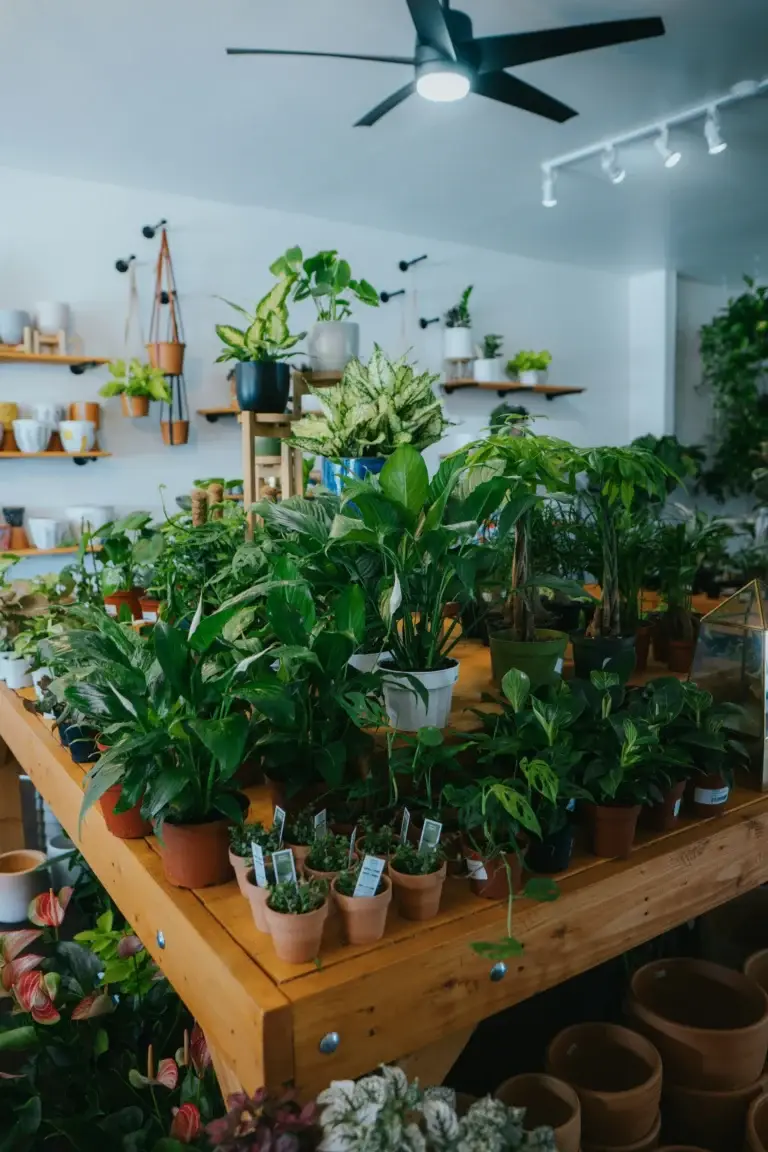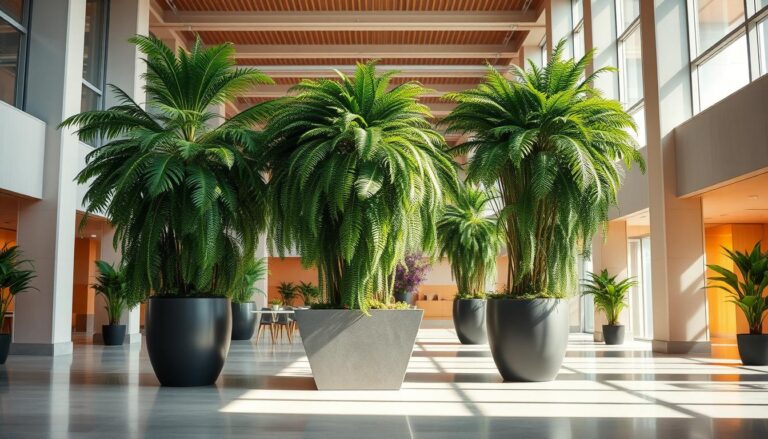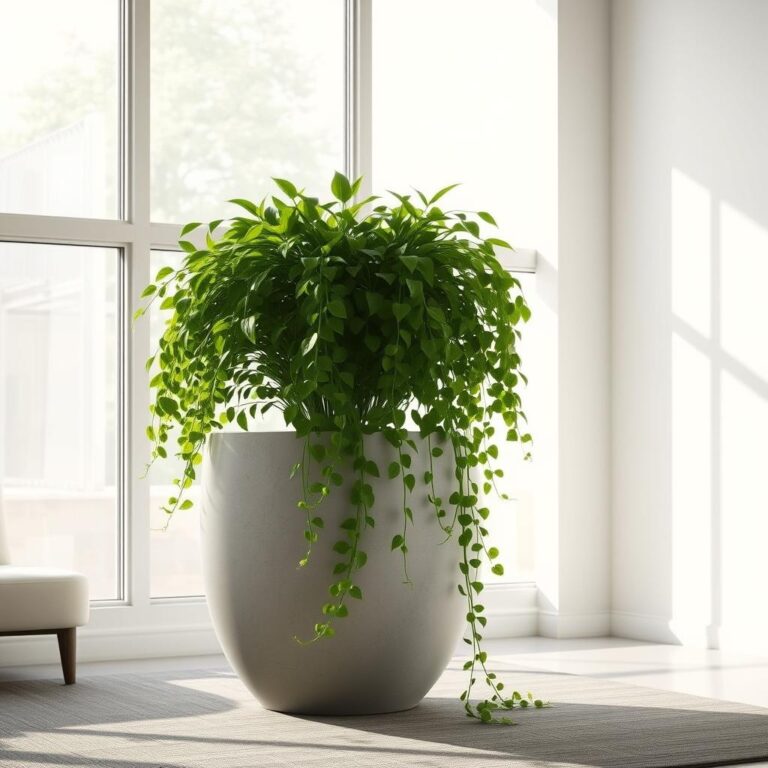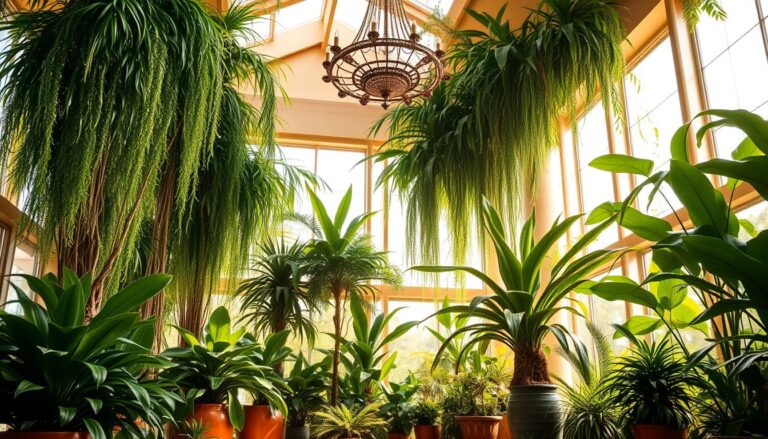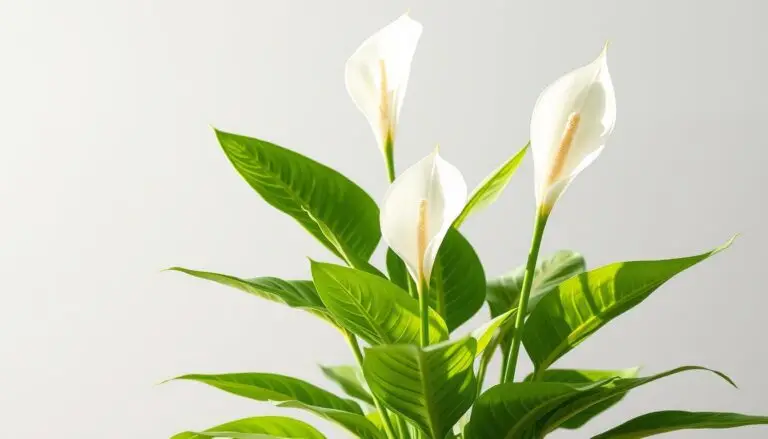Discover the Best Tall Indoor Plants for Your Home
tall indoor plant? Have you ever walked into a room and felt it lacked soul? I did – until I brought home a lush, leafy companion that turned my blank walls into a living gallery. Statement-making greenery does more than fill empty corners. It whispers stories of growth, cleans the air you breathe, and becomes an instant conversation starter.
Imagine a focal point that evolves with you. The Fiddle Leaf Fig, with its sculptural branches and broad leaves, doesn’t just occupy space – it commands attention like a timeless painting. These natural giants filter toxins while creating rhythm in your décor, their vertical lines drawing the eye upward to make ceilings feel higher.
Choosing the right specimen is like selecting a lifelong friend. Consider how sunlight dances through your windows or which leaf patterns make your heart skip a beat. This isn’t about trends – it’s about finding a botanical partner that reflects your personality and thrives in your unique environment.
Table of Contents
Introduction: Elevate Your Home with Greenery
Your living area becomes a sanctuary when greenery breathes life into its corners. Studies show leafy companions reduce stress by 37% while filtering airborne toxins. Bright indirect light streaming through windows becomes fuel for photosynthesis, turning empty nooks into thriving ecosystems.
Not all spaces receive equal sunlight. North-facing rooms with low light conditions suit species like peace lilies, while sun-drenched areas allow rubber trees to flourish. A NASA study found certain varieties remove 87% of air pollutants within 24 hours – nature’s air purifiers working silently in your home.
Vertical placement matters as much as horizontal space. Floor-to-ceiling specimens create layered depth, making compact apartments feel expansive. Designers often use towering greenery to draw attention to architectural features or soften sharp angles.
Beyond aesthetics, research from the University of Exeter reveals office workers near foliage report 15% higher productivity. Your choice of living décor becomes a wellness tool – improving focus during video calls or adding calm to chaotic mornings.
Ready to transform your environment? The following sections reveal how to match species to your lifestyle and space constraints while maximizing health benefits.
Benefits of Tall Indoor Plants
Ever notice how stale air disappears when greenery enters the room? Larger specimens work like natural air scrubbers. Their expansive foliage absorbs airborne chemicals from cleaning products and furniture finishes. A single specimen stretching several feet tall can process 30% more pollutants daily than smaller counterparts.
Nature’s Chemical Neutralizers
Broad leaves act like biological sponges. Species with dense foliage – think rubber trees or monstera – trap benzene and formaldehyde effectively. NASA research confirms leafy giants remove toxins 40% faster than compact varieties. More surface area means better filtration.
Your Brain on Greenery
Living with leafy companions reduces cortisol levels by 15%, according to Harvard studies. Their presence creates calming visual anchors during stressful tasks. Workers near foliage report 20% higher focus levels than those in bare offices.
| Feature | Large Varieties | Small Varieties |
|---|---|---|
| Daily Toxin Removal | Up to 87% | 35-50% |
| Visual Impact | Immediate focal point | Subtle accents |
| Maintenance | Weekly care | Daily attention |
Placement matters for maximum benefit. Position your green companion near seating areas where you relax or work. The combination of cleaner air and organic shapes creates an environment where creativity thrives naturally.
How to Choose the Right Tall Indoor Plant
What separates thriving greenery from struggling specimens? The answer lies in matching your space with species that love your home’s unique conditions. Start by sketching sunlight patterns in your rooms and measuring vertical clearance. A well-chosen companion grows with your lifestyle rather than against it.
Considering Space and Lighting Conditions
South-facing windows bathe floors in bright indirect light for 6+ hours daily – perfect for fiddle leaf figs. North-facing areas with softer illumination suit snake plants. Measure ceiling height before selecting: rubber trees stretch to 8 feet, while dwarf palms cap at 5 feet.
Observe how sunlight moves through your rooms. Morning rays suit delicate species, while harsh afternoon beams demand light-diffusing curtains. Dark corners? Cast iron plants thrive with just 50 lux – equivalent to twilight conditions.
Assessing Maintenance and Growth Requirements
Fast-growing species like monstera need monthly fertilization and annual repotting. Slow growers like ZZ plants demand minimal care. Check root systems: moisture-loving varieties require deep pots with drainage, while succulents prefer shallow containers.
Soil type dictates watering frequency. Cactus mix dries quickly for drought-tolerant species. Peat-based blends retain moisture for tropical varieties. Match care routines to your schedule – overwaterers should avoid ferns, while frequent travelers might choose ponytail palms.
Light Requirements and Indoor Placement
Your green companion’s health starts with decoding your home’s light language. Different species thrive under specific illumination levels – get this right, and you’ll see leaves flourish. Get it wrong, and you’ll witness slow decline.
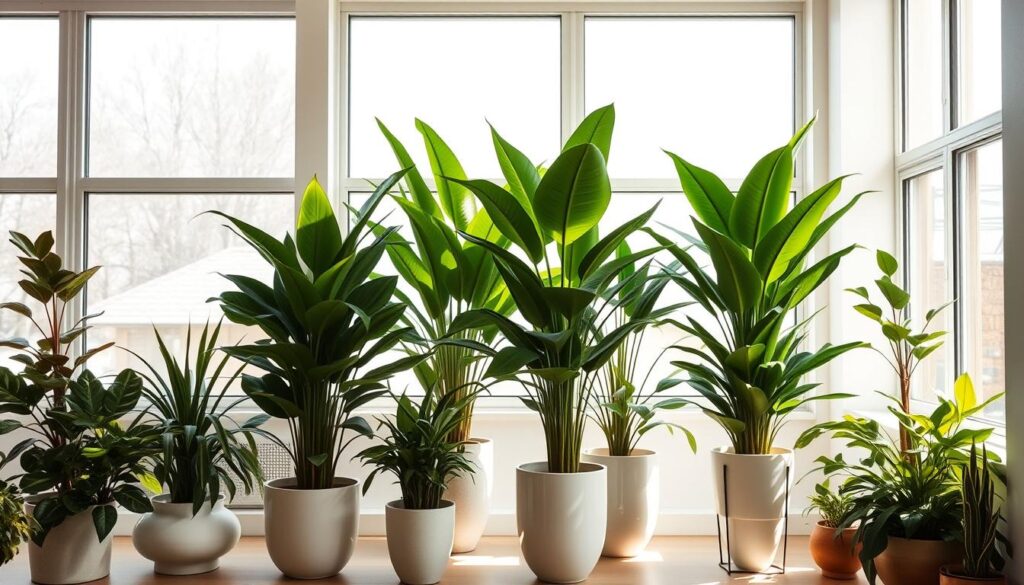
Bright Indirect vs. Low Light Options
Bright indirect light means sunbeams never directly hit foliage. Place specimens 3-5 feet from south-facing windows where sunlight bounces off walls. Ficus Audrey trees stretch toward this filtered glow, developing thick, waxy leaves.
North-facing rooms or spaces far from windows offer low light conditions. Snake plants and ZZ varieties survive here, growing slower but maintaining structure. Their vertical forms add height without demanding prime window real estate.
| Light Type | Lux Levels | Best Locations |
|---|---|---|
| Bright Indirect | 10,000-20,000 | East-facing bay windows |
| Low Light | 50-2,500 | Hallways, north rooms |
Morning sunlight through east windows gently warms leaves. Afternoon western exposure often needs sheer curtains to prevent scorching. Rotate potted greenery weekly so all sides receive equal illumination.
Track seasonal changes. Winter sun sits lower, casting longer shadows. Summer foliage might need pulled back from hot glass. Observe leaf color – deep greens mean happiness, while yellowing suggests light stress.
Watering, Soil, and Humidity Essentials
Mastering moisture levels transforms plant care from guesswork to science. Your leafy companion’s survival depends on three pillars: balanced hydration, proper soil structure, and air quality. Even mature greenery needs precise care to maintain its grandeur.
Soil: The Foundation of Health
Dense root systems demand specific earth blends. Cactus mix drains quickly for drought-tolerant varieties, while peat moss retains moisture for tropical species. A study by the Royal Horticultural Society found using correct soil reduces root rot by 68%.
| Soil Type | Best For | Drainage Speed |
|---|---|---|
| Sandy Loam | Snake Plants | Fast |
| Peat-Based | Fiddle Leaf Figs | Moderate |
| Coconut Coir | Monstera | Slow |
Check soil weekly. Insert your finger up to the second knuckle – dryness means watering time. Overly damp earth? Delay hydration to prevent suffocated roots.
Humidity Harmony
Leafy giants thrive at 40-60% humidity. Bathrooms naturally meet these conditions, while living rooms often need pebble trays or misting. Browning tips signal arid air – a common issue in heated homes during winter.
Grouping greenery creates microclimates. Their collective transpiration raises moisture levels naturally. For solo specimens, use a hygrometer to monitor environmental changes.
Established roots still need attention. Compacted soil starves oxygen supply, while mineral buildup alters pH balance. Refresh topsoil annually and flush containers every 6 months to maintain vitality.
Designing Your Living Space with Indoor Plants
What transforms a house into a sanctuary? A living room where leaves brush against sunlight and shadows dance across walls. Greenery isn’t just décor – it’s living architecture that shapes how you experience your home.
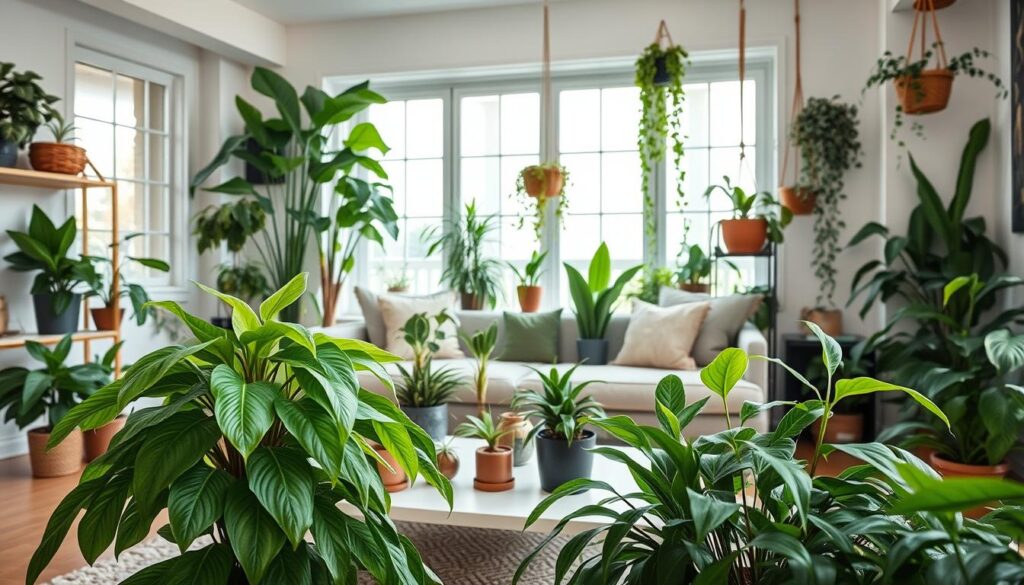
Start by choosing a focal point. A single specimen with sculptural branches, like a fiddle leaf fig, anchors seating areas naturally. Pair it with textured throws or earthy ceramics to create visual harmony. “Plants become partners in design – their organic forms soften sharp lines and add movement,” notes interior designer Mara Santos.
Scale matters for balance. In compact corners, opt for slender varieties that reach ceiling height without overwhelming. Open floor plans? Cluster three staggered specimens to create depth. Always leave 18-24 inches between pots and furniture for growth space.
| Room Style | Plant Pairing | Design Effect |
|---|---|---|
| Modern Minimalist | Snake Plant + Concrete Pot | Clean lines, contrast |
| Bohemian | Bird of Paradise + Woven Basket | Warmth, texture |
| Traditional | Kentia Palm + Brass Planter | Timeless elegance |
Light plays double duty. Position leafy companions near windows to cast intricate shadows at sunrise. Use grow lights disguised as pendant lamps in darker areas. This approach blends function with artistry – your greenery thrives while becoming part of the lighting design.
Finally, let your space breathe. Rotate specimens seasonally to refresh layouts. A monstera by the summer sofa might shift to frame the winter fireplace. Your home evolves organically, each change reflecting nature’s rhythm and your personal style.
Our Top Tall Indoor Plant Picks
Transform empty corners into vibrant focal points with these expert-approved greenery selections. Each variety offers distinct benefits – from air purification to symbolic charm – while adapting to common household conditions.
Lush Fiddle Leaf Fig and Its Impact
The fiddle leaf fig dominates interiors with its broad, violin-shaped leaves. Place it 3-5 feet from east-facing windows for optimal growth. Water when the topsoil dries, typically every 10 days. Mature specimens reach 6-10 feet tall, making them natural room dividers.
Elegant Money Tree for Feng Shui
Braided trunks and glossy leaves make the money tree a prosperity symbol in Feng Shui practice. It thrives in medium light and weekly watering. This variety grows 3-6 feet tall, fitting perfectly beside home offices or entryways for positive energy flow.
Resilient Snake Plant for Beginners
Vertical sword-like leaves define the snake plant, surviving low light and irregular watering. NASA research confirms its exceptional air-purifying abilities. Perfect for busy households, it grows 2-4 feet tall with minimal care.
| Variety | Light Needs | Water Frequency | Max Height |
|---|---|---|---|
| Fiddle Leaf Fig | Bright indirect | Every 10 days | 10 feet |
| Money Tree | Medium | Weekly | 6 feet |
| Snake Plant | Low to bright | Biweekly | 4 feet |
Rotate these specimens monthly for even growth. Use ceramic pots with drainage holes to prevent root issues. Their vertical forms create visual height in compact spaces without overwhelming furniture layouts.
Exploring Unique Varieties
Ever feel your space needs a green twist beyond the ordinary? Step past common picks and meet botanical standouts that redefine vertical décor. These selections blend practicality with striking aesthetics, adapting to modern lifestyles while demanding minimal real estate.
Ficus Audrey Tree and Australian Umbrella Tree
The Ficus Audrey flaunts velvety leaves with pale veins, thriving in medium to bright indirect light. Unlike its finicky cousin (the fiddle leaf fig), it tolerates occasional missed waterings. Perfect for narrow corners, its upright growth rarely exceeds 4 feet wide.
Australian Umbrella Trees bring tropical drama with finger-like leaflets. Their slim profile fits snugly beside bookshelves or entryways. Water when the top 2 inches of soil dry out – about every 12 days. Both varieties filter airborne toxins while adding organic texture.
Modern Alternatives: Cat Palm and Cordyline Harlequin
Pet owners adore the Cat Palm for its non-toxic, feathery fronds. This palm variety thrives in humid spaces like sunlit bathrooms, growing 5-6 feet tall. Group three in a staggered formation for instant jungle vibes.
Cordyline Harlequin steals shows with pink-streaked leaves. It demands bright light to maintain its candy-cane stripes. Rotate weekly to prevent lopsided growth. Ideal for adding vertical color accents in monochrome rooms.
- Ficus Audrey: Dust leaves monthly for optimal photosynthesis
- Umbrella Tree: Prune lower stems to emphasize trunk structure
- Cat Palm: Mist twice weekly if humidity drops below 40%
- Cordyline: Use well-draining soil to prevent root rot
Care Tips for Your tall indoor plant
What’s the secret behind those lush, vibrant leaves you admire in magazine spreads? Consistent care transforms ordinary greenery into showstopping focal points. Proper maintenance ensures your botanical companion thrives while performing its air-purifying magic.
Pruning, Dusting, and Leaf Maintenance
Sharp, clean shears make all the difference. Trim yellowing foliage at the base to redirect energy to healthy growth. Always cut above leaf nodes – this encourages bushier development. “Strategic pruning prevents legginess while maintaining structural integrity,” advises botanist Lila Chen.
Dust accumulation blocks photosynthesis. Wipe broad leaves monthly with a damp microfiber cloth. For textured varieties like fiddle leaf figs, use a soft brush to clean crevices. Avoid commercial leaf shine products – they clog pores.
| Tool | Purpose | Frequency |
|---|---|---|
| Pruning Shears | Remove dead growth | Every 2 months |
| Microfiber Cloth | Surface cleaning | Monthly |
| Soft Brush | Detailed dusting | Biweekly |
| Neem Oil Spray | Pest prevention | Seasonally |
Over-dusting harms more than helps. Limit deep cleaning to once per season unless leaves appear visibly dirty. Check undersides during maintenance – this is where pests often hide.
Healthy foliage maximizes air purification. Damaged or dusty leaves process 30% fewer toxins. Establish a rotating care schedule – alternate pruning and cleaning weeks to avoid stressing your greenery.
Low-Maintenance Options for Busy Lifestyles
Between work deadlines and family commitments, your greenery shouldn’t become another chore. Certain species thrive on minimal attention while maintaining their sculptural beauty. These resilient varieties adapt to irregular care, making them perfect for modern schedules.
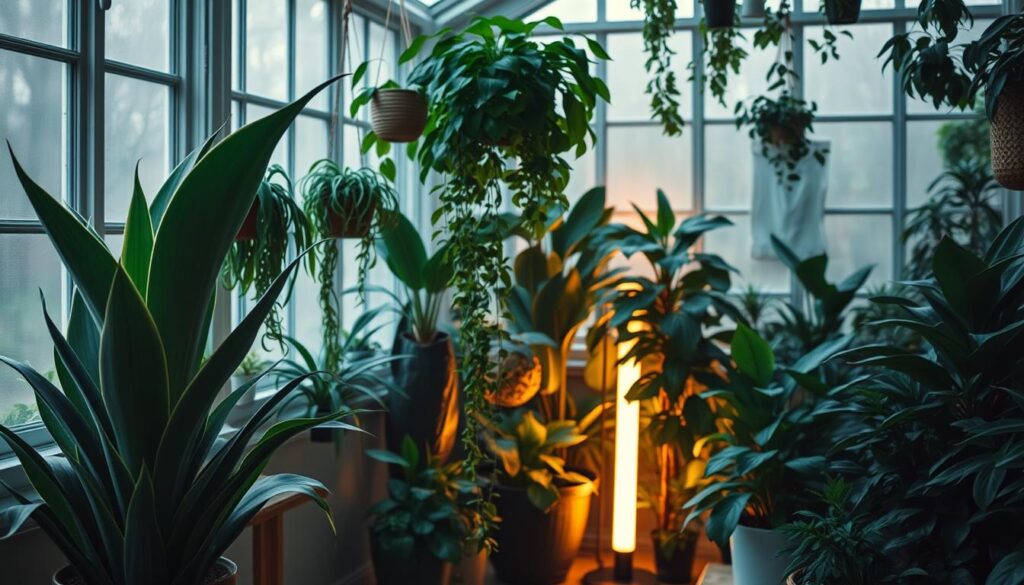
Spotlight on ZZ Plant and Snake Plant Ease
The ZZ Plant survives months without water thanks to potato-like rhizomes storing moisture. Its waxy leaves reflect light in dim corners, requiring just 50 lux – equivalent to candlelit dinners. Place it in that awkward corner behind your sofa, and watch it flourish.
Snake Plants work overtime while you sleep. They convert CO2 into oxygen at night, ideal for bedrooms or home offices. Water them every 3-4 weeks, and they’ll reward you with vertical growth reaching 4 feet tall. Even black-thumbed beginners succeed with these warriors.
| Feature | ZZ Plant | Snake Plant |
|---|---|---|
| Water Needs | Every 6-8 weeks | Every 3-4 weeks |
| Light Tolerance | Low to bright | Low to indirect |
| Growth Speed | Slow (6″/year) | Moderate (12″/year) |
Both varieties handle dry air from heating systems and ignore dust buildup. Forgot your last watering date? Their soil should completely dry between drinks. Rotate pots quarterly to prevent leaning – their only real demand.
Designers love pairing these with concrete planters for urban aesthetics. Cluster several heights together for instant visual impact without daily upkeep. Your space stays refreshed while you focus on life’s bigger priorities.
Maximizing Indoor Space with Large Plants
Ever stare at that awkward empty corner and wonder how to make it sing? Oversized greenery transforms dead zones into living sculptures. A 10-foot Kentia Palm becomes both art and architecture, its feathery fronds creating privacy screens in open areas. These natural giants work harder than furniture – purifying air while shaping your space’s flow.
Strategic Placement for Open Floor Plans
Position specimens to define zones without walls. Cluster three staggered large indoor plants near seating areas to create intimate nooks. The tallest should reach 70% of your ceiling height – this proportion feels harmonious. Leave 24 inches between pots and walkways for comfortable movement.
Use vertical lines to guide the eye. Place a slender fishtail palm beside floor-to-ceiling windows. Its upward growth emphasizes height, making rooms feel airier. Rotate leafy companions quarterly to maintain balanced shapes that complement your layout.
| Location | Plant Type | Design Impact |
|---|---|---|
| Between zones | Kentia Palm | Soft division |
| Behind sofa | Fiddle Leaf Fig | Depth creation |
| Entryway | Yucca Tree | First impression |
Styling Small Corners with Big Presence
Even tight spaces deserve drama. Choose varieties that grow upward rather than outward – a 6-foot snake plant adds height without crowding. Position pots diagonally in corners to maximize floor space. Reflective planters bounce light into shadowy areas, doubling visual impact.
Monitor conditions carefully. Corners often have lower light and airflow. Opt for resilient species like ZZ plants that tolerate these challenges. Keep temperatures between 65-75°F for optimal growth, using a digital thermometer to track fluctuations.
Single specimens make powerful statements. A towering bird of paradise beside your reading chair turns functional seating into a tropical retreat. Its broad leaves filter afternoon sun while adding organic texture to minimalist spaces.
Decorating Ideas for a Greener Home
What if your décor could evolve with the seasons while cleaning your air? Strategic greenery placement turns functional spaces into living art galleries. Start by matching leaf textures to your existing color palette – velvety calatheas complement velvet cushions, while glossy monsteras echo glass tabletops.

Balance bold specimens with negative space. A single statement piece like a bird of paradise needs breathing room to shine. Frame it with minimalist furniture and neutral walls. “Greenery becomes the jewelry of a room – let it sparkle against simple settings,” suggests designer Elena Marquez.
Maximize bright indirect light by positioning leafy companions near east-facing windows. This illumination enhances variegated patterns without scorching delicate leaves. Rotate pots weekly to ensure even growth and maintain symmetrical shapes.
| Style | Pairing | Light | Effect |
|---|---|---|---|
| Scandinavian | Rubber Tree + White Planter | North-facing | Airy minimalism |
| Industrial | Yucca + Metal Stand | South-facing | Edgy contrast |
| Coastal | Areca Palm + Wicker | West-facing | Beachy vibes |
Create depth through height variations. Place a 6-foot dracaena behind a low sofa, then add medium-sized ferns on side tables. This layered approach guides the eye upward while maintaining conversation-friendly sightlines.
Refresh your space seasonally. Swap summer’s trailing pothos for winter’s structural succulents. Use decorative pebbles or moss to conceal soil surfaces, blending nature with your interior design aesthetic seamlessly.
Troubleshooting Common Plant Issues
Even resilient greenery faces challenges over time. Yellowing leaves or stunted growth often signal environmental mismatches. Catching issues early prevents long-term damage and keeps your leafy companions thriving.
Decoding Warning Signs
Drooping foliage usually points to watering problems. Check soil moisture before reacting – dry earth needs hydration, while soggy roots demand drainage fixes. Brown leaf tips often indicate low humidity or mineral buildup from tap water.
| Issue | Visible Signs | Quick Fix |
|---|---|---|
| Overwatering | Yellow leaves, mushy stems | Let soil dry completely |
| Pests | Webbing, sticky residue | Apply neem oil weekly |
| Low Light | Leggy growth, small leaves | Move nearer to windows |
Fluctuating temperatures stress specimens. Keep greenery away from drafty windows and heating vents. Most varieties prefer steady 65-75°F ranges for optimal health.
Flowers may refuse to bloom if light conditions change. Rotate pots regularly to ensure even exposure. For stubborn cases, supplement with full-spectrum grow lights placed 12-18 inches above foliage.
Long-term success requires seasonal adjustments. Repot root-bound specimens every 2-3 years using fresh soil. Wipe leaves monthly to maintain photosynthesis efficiency and inspect for hidden pests.
“Diagnose issues systematically – check light, water, and airflow before treating symptoms.”
Expert Advice from Greenhouse Professionals
Ever wonder why some greenery thrives while others barely survive? Virtual consultations with horticulture experts reveal surprising truths about nurturing botanical companions. Their collective wisdom helps you avoid costly mistakes while maximizing your space’s potential.
Insights from Virtual Plant Consultations
Professionals emphasize matching species to your lifestyle first. “Many clients choose dramatic specimens without considering care requirements,” notes greenhouse manager Clara Bennett. Weekly virtual sessions show 73% of plant struggles stem from improper light or watering habits.
The Money Tree earns consistent praise for dual benefits. Its braided trunk symbolizes prosperity in Feng Shui, while glossy leaves thrive in medium light. Experts recommend rotating it monthly to prevent uneven growth – a common oversight.
| Expert Tip | Common Mistake | Solution |
|---|---|---|
| Check soil weekly | Overwatering | Use moisture meter |
| Dust leaves monthly | Ignoring pests | Neem oil treatment |
| Rotate pots | Leaning growth | Quarterly turns |
Low light areas challenge many owners. Professionals suggest snake plants or ZZ varieties for these zones, advising against forcing sun-loving species into dim corners. Proper placement reduces leaf drop by 40% according to recent case studies.
“Your greenery tells its needs through leaf color and posture – learn its language.”
Seasonal adjustments prove critical. Winter demands reduced watering frequencies, while summer growth spurts require nutrient boosts. Track these changes through simple journaling or plant care apps recommended by experts.
Sustainable Indoor Gardening Practices
Imagine nurturing greenery that grows healthier each season while reducing your environmental footprint. Sustainable care begins with soil management – mix used earth with organic compost instead of discarding it. This reduces waste and provides natural nutrients for years of growth.
Maintain humidity without energy waste. Place water-filled trays near heat sources during winter, letting evaporation naturally moisten leaves. In spring, open windows during rainy days to refresh air and hydrate specimens naturally.
| Practice | Resource Saved | Benefit |
|---|---|---|
| Rainwater Collection | Tap Water | Mineral-free hydration |
| DIY Pest Spray | Chemicals | Safe for pets/kids |
| Composting | Fertilizer | Rich soil nutrients |
Revitalize containers every 2-3 years instead of buying new. Sand wooden planters and apply natural linseed oil. For plastic pots, sanitize with vinegar solution to extend usability.
Spring growth spurts demand smart adjustments. Propagate cuttings in reused glass jars rather than purchasing starters. Rotate specimens weekly to ensure even light exposure, reducing artificial lighting needs.
“True sustainability means working with nature’s rhythms, not against them.”
Group moisture-loving varieties to create shared humidity zones. This microclimate approach cuts individual watering needs by 25% while mimicking their native habitats.
Conclusion
Your home deserves more than ordinary décor—it craves living sculptures that breathe. Whether you choose a six-foot-talI statement piece or cluster several specimens, these natural wonders transform spaces while nurturing wellness. They’re not just décor, but partners in creating healthier, more inspiring environments.
From air purification to stress reduction, the benefits multiply with each new leaf. Architectural varieties like fiddle leaf figs or snake plants become functional art, their vertical forms enhancing room proportions. Strategic placement near windows or seating areas maximizes both growth potential and visual impact.
Remember what experts emphasize: match species to your light patterns and lifestyle. Sustainable practices like rainwater collection keep your greenery thriving for years. Even a five-foot-tall companion can become a cherished part of your daily rhythm.
Ready to begin? Start with one resilient variety and watch how it reshapes your space—and perspective. Every new shoot marks progress in your journey as a caretaker of living beauty. Your home’s transformation begins with a single pot and a bold vision.


